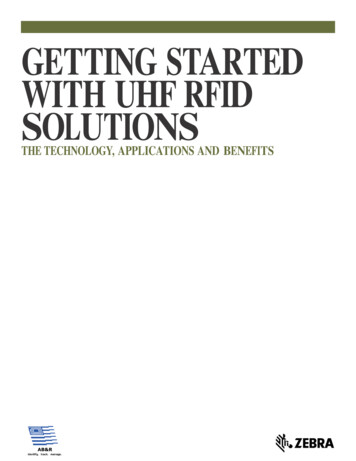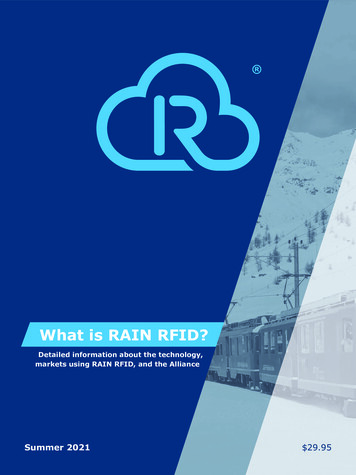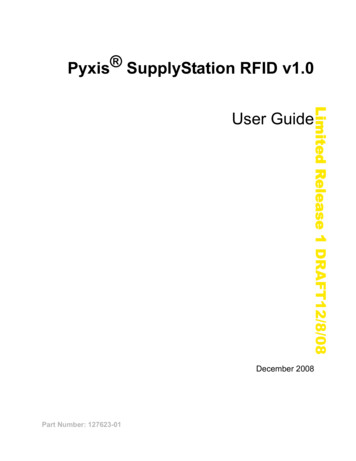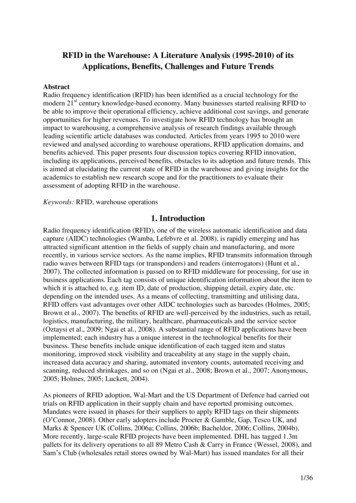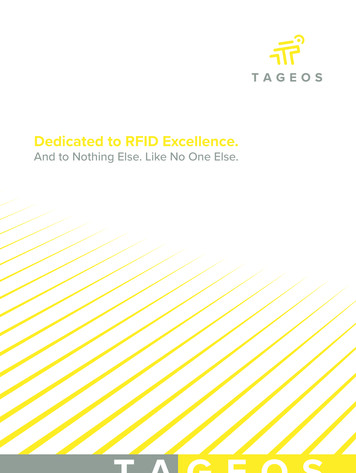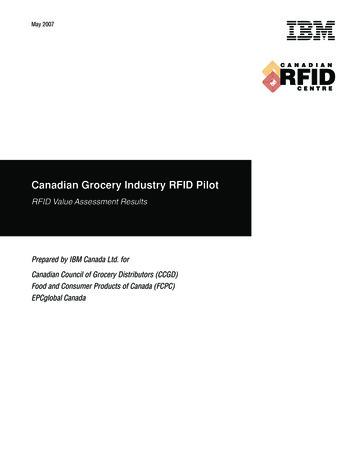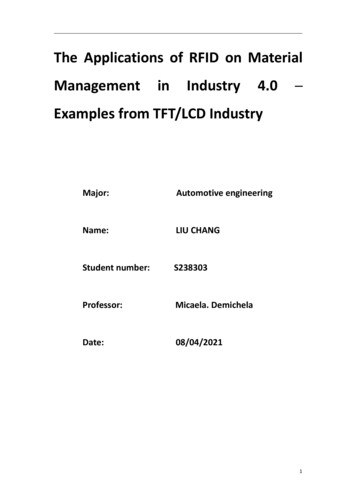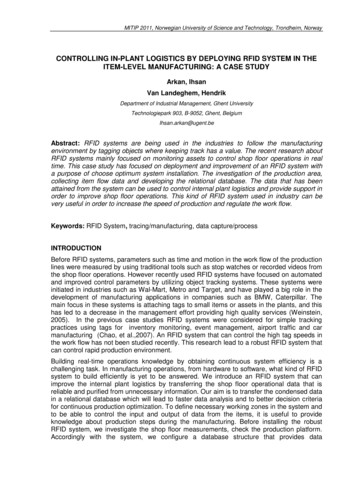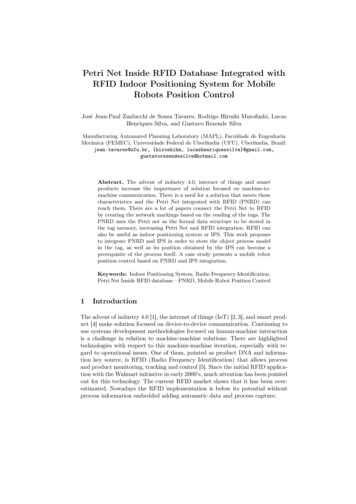
Transcription
High-Memory RFID for Aerospace,Manufacturing, MRO and RemoteAsset ManagementGOING OFF THE GRIDUsing High Memory RFIDElectronic asset tracking with radio frequency identification (RFID) is now the industry standard for themilitary, aerospace and retail markets. Generally, the method of storing information on the RFID tag iscustomized for each market. While the retail industry relies on a 96-bit electronic product code (EPC)number that acts like a unique electronic barcode, other industries require more memory storagecapabilities.For situations where an asset does not have guaranteed access to a network or does not want to shareinformation across organizations, high memory tags provide a compelling value proposition. Manufacturerscan get visibility into production demands and reduce parts inventory. Suppliers could improvemanufacturing efficiencies and verify the authenticity of their parts to fight counterfeiting. Airlines andmaintenance companies could make MRO operations, largely paper-based, more efficient so spare partscould be located more quickly, reducing flight delays and cancellations, and potentially saving hundreds ofmillions of dollars each year.In this whitepaper, we will take a look at high memory RFID tags, applications that can utilize high memorytagging, and the advantages that can be gained by integrating high memory RFID tags into an applicationsuch as maintenance, repair and overhaul (MRO) and asset management.Xerafy.com High Memory RFID for Aerospace, Manufacturing, MRO and Remote Asset Management 1
High Memory RFID TagsRFID tags are commonly used as an electronicbarcode. However, the disposable nature andshort lifetime of retail supply chains is hardly agood analogy for applications like the life-cycleoptimization of important assets – and nor is ittherefore a good blueprint on which to base asolution.High Memory tags have memory sizes up to 32Kbytes that allow users to add, edit, and recallrecords. The tag data format is readilyconfigurable and complies with an open standardformat ISO/IEC 18000-6 Type C (EPCglobal Gen 2).High memory tags can deliver significant value inthe following areas: operating location,information sharing across organizations,durability, security, information availability, andsimplification of deployment without the need forcomplex IT integration.Remote locations do not have easy access tonetworks. High memory tags take RFID into thefield, providing information in remote locationsand reducing the need for contact with network.Several organizations are typically involved in theprocess of manufacturing, using and maintainingany asset, and within an organization, severalgroups are involved in procuring, installing, usingand decommissioning it. As a result, the key lifecycle history information for that asset is widelydistributed, and the implementation andintegration complexities associated with makingthis information available over a network can bepunitive in terms of both cost and time-scale.Organizational issues and concerns can arise.High memory tags enable the "just the rightamount" of data to be shared, controllingdissemination of data and reducing theprobability of any liability issues occurring.Since Xerafy has the toughest UHF RFID onmetal and embed-in metal tags on the market,the XL series tags are a perfect fit for highmemory chip, which are needed in some of themost challenging applications out there.Xerafy’s Sky-ID Global Tag with Tego's 8K byte ICAvailable in the smallest form factor that survivethe extreme applications without sacrificingperformance, and in contrast to inexpensivememory technologies used in consumer markets,high memory tags incorporate “bulletproof”technology that can withstand time, temperature,pressure and radiation. Tags that are designed towithstand extreme conditions such as repeatedgamma sterilization and exposure to hightemperature are the safest solution for long-lifeassets in harsh environments and greatly reducethe risk of an expensive field recall ormaintenance to address tag memory issues.The information about a tagged asset is alwaysavailable with the asset, ensuring availability ofinformation at all times. This is especiallyvaluable when for example infrastructure isimpaired as a result of a disaster such ascatastrophic weather conditions. After suchevents, if any telecommunications circuitsremain intact, they are typically overloaded. Highmemory tags can still provide valuableinformation about the maintenance andconfiguration history of parts and accelerate theprocess of getting infrastructure up and runningagain.Since these tags are designed to operateanywhere, they can also be deployed rapidlywithout the need at the outset for complex ITintegration or additional server and networkingcapabilities.All of the components necessary for a solution,such as hardware, enabling software andinteroperability standards are already in place.Indeed, many customers have been live in lessthan a week reading and writing information tokey assets.High memory tags behave as remote agents thatintelligently gather, store and provide informationXerafy.com High Memory RFID for Aerospace, Manufacturing, MRO and Remote Asset Management 2
when and where it is needed and is applicable tomany industries in use cases that include: Recording asset history: maintenancerecords in aviation, oil and gas, andindustrial manufacturing Managing product configuration: traceabilityof parts in aviation, defense and automotiveapplications Increasing security: secure smart cards withbiometric information that includes facialimages and with sensitive Proving authenticity: authenticated legaldocuments and records via digital signature; Tracking assets in harsh environments: tagsthat can survive high temperatures inengines or repeated exposure to radiation innuclear power plants Recovering from natural disasters or otherevents: accessing inventory andconfiguration of in-field assets by utilitycompanies Battery-free sensing, monitoring andcontrol: temperature, pressure, shocksensing, and environmental monitoring bytransportation, building, and alternativeenergy companiesXerafy XL tags with Tego's ICAerospaceThe aviation industry has been the leader inestablishing standards for tag interoperabilityacross organizations, and Tego, a worldwideprovider of high memory RFID integrated circuits,worked closely with industry organizationsincluding aircraft manufacturers, maintenanceand repair (MRO) organizations, airlines andequipment manufacturers to establish the AirTransportAssociation(ATA)Spec2000specification for “RFID on Parts.”The aviation industry has a compelling valueproposition for tagging flyable parts, with asignificant return on investment to the taggingorganization, and a subsequent benefit for allorganizations involved in the maintenance andmanagement of aviation parts over their lifecycle.Benefits include: Improved aircraft configuration managementand line maintenance Visibility of full maintenance history acrossorganizations Reduced occurrence of "no fault found"conditions Life-limited parts tracking and optimization Reduced cost of compliance documentation Recorded pedigree for end of leaseThe A350 widebody will be the first Airbus aircraftto use the passive RFID tags on flyable parts.Boeing has said it will use RFID tags for“maintenance-specific parts” on the 787Dreamliner. Airbus would apply RFID highmemory tags to airplane components for its A350extra wide-body (XWB) airplane at the source ofmanufacture. Information from the tags is usedto better support aircraft configurationmanagement and line maintenance, repair shopoptimization and life-limited parts monitoring.Airbus is requiring that most parts be tagged withRFID tags. Currently, Airbus expects that up to3,000 aircraft parts will be tagged on each plane,with 2,000 of these tags being high memory tagscarrying 4 kilobytes or more of storage. After theplanes are delivered into service starting in 2013,carriers will use the high-memory tags to storemaintenance histories directly on certain flyableXerafy.com High Memory RFID for Aerospace, Manufacturing, MRO and Remote Asset Management 3
aircraft parts and components. The data will beused to improve a host of processes, includingconfiguration management, repair operationsand warehouse logistics.Other applications that would benefit from highMRO ManagementUtility companies face great difficulty in disastermemory tags include oil and gas exploration,military vehicle and material maintenance, utilitypole configuration, and railroad maintenance.recovery when crews from around the nationconverge on a scene to restore infrastructure.Coordinating repairs and organizing parts toreconfigure every downed utility pole is amonumental effort. By tagging utility poles withpermanent line/pole maintenance records, acrew sent from any distant region can simplyscan a downed pole and know exactly what theyneed to replace it.The aviation industry is only the beginning forConclusionhigh-memory, passive RFID tags. Smart solutionswith intelligent tags will find their way quicklyinto many industries in asset management andother business areas. These include: Remote assets in renewable energy Valves and maintainable items in processindustries Manufacturing equipment at CPG plants Trains and other transportation assets Hazmat material in the nuclear industry are industryTheseindustriescommonproblems in asset management and MRO.Studies have found many examples where only 20percent of a technician’s time involved productivework. Eighty percent of repair time was spentgathering information and tracking parts andtools to set up the job.Similarly, lifted assets or assets requiringperiodic maintenance are regularly either takenout of service prematurely (reducing theireconomic life) or miss key maintenance events,creating potentially hazardous situations andexposing organizations to liability issues.High memory tagging solutions transform thelife-cycle management and overall effectivenessof business assets, and do so in a manner thatdelivers the lowest total cost of ownership, andinitial deployment that is rapid and inexpensive.High memory RFID tags differ from license plateRFID tags because they store data on the tagsand do not rely on a network and they are built tolast the lifetime of the asset. High memory RFIDtags can transform logistics, maintenance, andasset management in situations where storinginformation on the network is prohibitive due toavailability, security, or complexity of theinformation sharing.The fact that information is stored directly on thetag reduces overall cost of the managementsystem since information is instantly received,recorded, and detected.Xerafy.com High Memory RFID for Aerospace, Manufacturing, MRO and Remote Asset Management 4
High memory tags can also be used inconjunction with regular RFID tags to provide abroad range of identification solutions. As PhilCoop, manager of Boeing’s GoldCard servicesdepartment for the Dreamliner and other fleetstold RFID Journal: “One size does not fit all whenit comes to RFID.”Rugged high memory RFID tags like the XerafyXL series tags are set to revolutionize the wayindustries manage their assets. Right now thereare pilot applications in multiple industries thatare looking to expand their RFID taggingoperations. The time to get started is now.Contact UsFor more information on high memory RFID tag applications, product overviews or any other questions,please contact Xerafy at info@xerafy.com.Xerafy.com High Memory RFID for Aerospace, Manufacturing, MRO and Remote Asset Management 5
Xerafy.com High Memory RFID for Aerospace, Manufacturing, MRO and Remote Asset Management 1 GOING OFF THE GRID Using High Memory RFID Electronic asset tracking with radio frequency identification (RFID) is now the industry standard for the military, aerospace and retail markets. Generally, the method of storing information on the RFID tag is .

